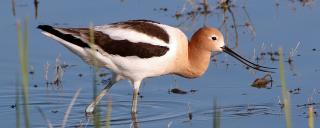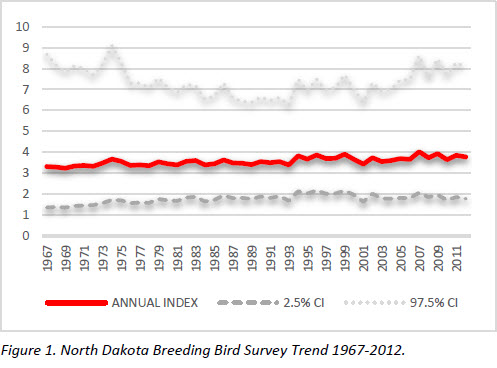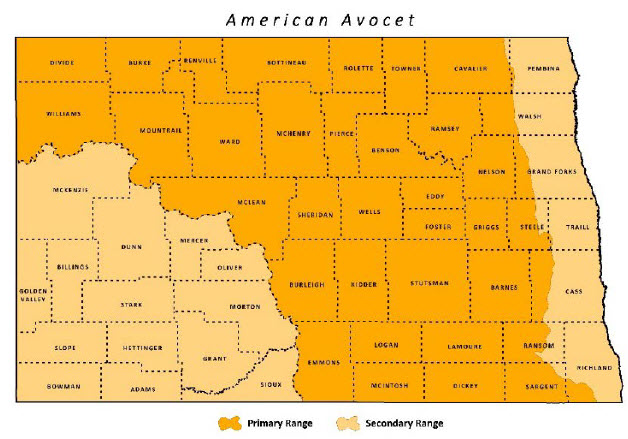
American Avocet
| Scientific Name | Recurvirostra americana |
|---|---|
| General Description | L 18", WS 31", 11 oz. Body is black and white with a striking orange-cinnamon head and neck, thin up-curved bill, and blue legs. |
| Status | Occurs in North Dakota from April to October. Peak breeding season mid-May to early July. |
| Abundance | Fairly common. |
| Primary Habitat | Wetlands or lakes with exposed, sparsely vegetated shorelines or islands. |
| Federal Status | Migratory Bird. |
| Reason for Designation | A high proportion of the population breeds in North Dakota. Listed as a U.S. Shorebird Conservation Plan Species of High Concern in the Prairie Pothole Region. Increased climate change vulnerability in Shorebirds of Conservation Concern 2015. |
Locations and Conditions of Key Habitat
Preferred Habitat
American Avocets are most commonly seen using exposed, sparsely vegetated salt flats, sandbars, peninsulas, mudflats, or islands with beaches. Generally use shallow water (less than 1m) in tilled, alkali, ephemeral, temporary, seasonal, semi-permanent, permanent wetlands, or lakes. Islands appear to host higher breeding densities than along shorelines. In North Dakota, avocets favored large islands with beaches, located in shallow water, and islands constructed in wetlands. The nest is usually located on unvegetated ground or in areas with short, sparse vegetation. Nests may be slightly elevated, within about 60 m of water, and often near a clump of vegetation or debris. Most often nest in loose colonies, sometimes in association with terns, but never with gulls, pelicans, or cormorants. Avocets will also nest solitary. Foraging usually takes place in shallow water less than 20 cm deep for aquatic invertebrates, small fish, seeds, or terrestrial vertebrates on land.
Key Areas and Conditions for American Avocet in North Dakota
No specific sites have been identified.
Problems Which May Affect this Species
Habitat
Breeding density may be determined by availability of island nesting grounds. Avocets do not use islands used by breeding gulls; and ring-billed gulls have increased substantially in North Dakota over the past 40 years. High water years can limit nesting substrate.
Other Natural or Manmade Factors
Nest losses attributed to flooding and predation. An elevated level of selenium has been found in avocet eggs in other areas. Selenium is present in evaporation ponds that receive subsurface agricultural drainage, such as irrigated fields. Human presence at nesting site during early laying stages can cause abandonment. Collision with power lines over wetlands has been documented. Expanding oil and gas development in North Dakota increases risk of oilfield contamination of wetland habitat.
Research and Survey Efforts
Current Research or Surveys
- Since 2004, the USFWS HAPET staff has coordinated a breeding shorebird survey in the Prairie Pothole Region of North and South Dakota. Surveys are conducted twice to correspond with the shorebird breeding season. Five grassland breeding shorebird species are targeted, including American Avocet. Results from these surveys help guide grassland and conservation efforts.
- Rocky Mountain Bird Observatory (ND SWG T-40-R) is conducting a statewide inventory of colonial and semi-colonial waterbird populations and identifying key sites for breeding colonies in North Dakota. The American Avocet is one of 29 target species. The project was initiated in March 2014.
Previous Research or Surveys
- Northern Prairie Wildlife Research Center (ND SWG T-3-1 and T-9-R) determined marsh bird distribution in relation to landscape composition in North Dakota. The project was initiated in 2004 and a final report provided 2008. American Avocets were one of 16 focal species. American Avocets were primarily observed on wetlands with cover classes of 3 or 4 and were treeless, and were on average 93% ±8 SE full (Sherfy and Anteau 2008).
- Avocet use of nesting islands in North Dakota was explored by Dahl (2003).
- Numerous published reports and gray literature throughout the species range and in North Dakota. Additional Research or Surveys Needed
- Determine the effects of selenium or insecticides on wetland quality and prey species.
Population and Trend Estimates

- North American Population Estimate 2012: 450,000
- North Dakota BBS Trend: see figure 1
- Survey-wide BBS Trend 1966-2012: -0.22
Management Recommendations
- Maintain wetland complexes and large wetlands or lakes.
- Manage vegetation on the periphery of islands for sparseness.
- Optimize invertebrate abundance in wetlands through timed drawdowns, disking and flooding.
- Conduct management control of gulls where impacting avocet nesting habitat.
- Utility development should follow the guidance of “Reducing Avian Collisions with Power Lines" including marking power lines and creating an Avian Protection Plan.
Monitoring Plans
The Breeding Bird Survey continues to be a useful monitoring tool, however the annual surveys implemented by HAPET in 2004 are valuable. Ensuring all BBS routes are conducted annually is priority. A shorebird monitoring plan should follow The International Shorebird Survey (ISS) Program for Regional and International Shorebird Monitoring (PRISM) and “Guidance for Developing and Implementing Effective Shorebird Surveys."
2005-2015 Progress
The American Avocet remains a Level II Species of Conservation Priority. Several State Wildlife Grant Projects (T2-9-R, T2-11-HM, T-18-R, T-21-D, T-22-HM, T-23-HM, T-25-HM, T-27-HM, T-37-D) have contributed to habitat enhancement of wetlands and grasslands for Willet and other wetland/grassland dependent birds.

Note: A listing of works consulted when compiling the information on this page may be found in the 2015 State Wildlife Action Plan.
